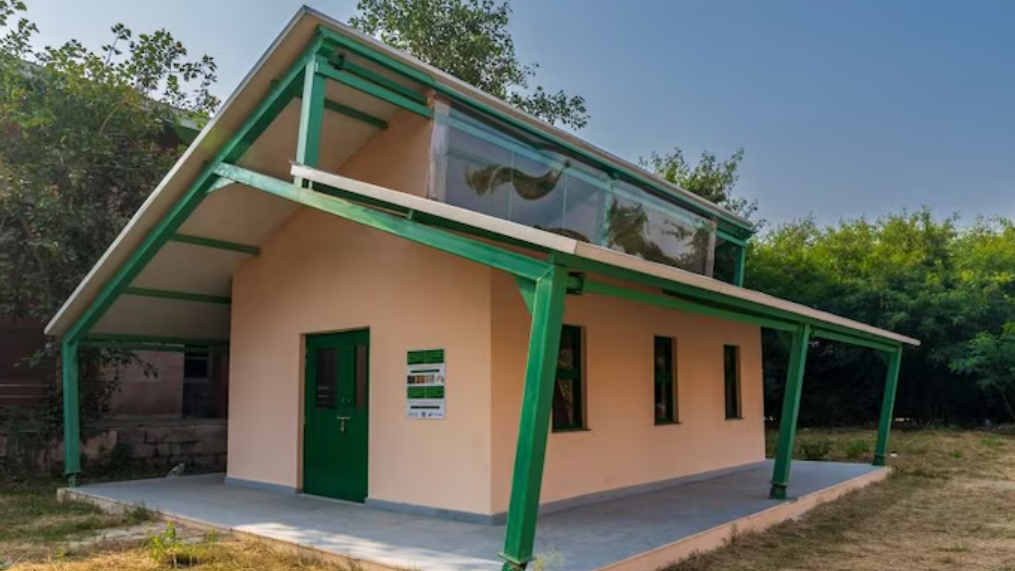Share This Article
A school made from sugarcane waste? It may sound like science fiction, but it’s already a reality in Noida, Uttar Pradesh. In a bold leap for low-carbon construction in India, the first-ever school building using Sugarcrete — a construction block made from sugarcane waste — has officially opened its doors.
This pioneering project is more than a showcase of material innovation. It’s a blueprint for how India can build sustainably, affordably, and inclusively—by transforming its agricultural byproducts into building blocks for the future.
What is Sugarcrete?
Developed in 2023 by researchers Alan Chandler and Armor Gutierrez Rivas at the University of East London (UEL), Sugarcrete is made from bagasse — the dry fibrous pulp left over after extracting juice from sugarcane — and combined with mineral binders.
The result? A carbon footprint six times lower than traditional fired bricks. No kiln. No cement. Just a smart use of what would otherwise be considered waste.
Noida’s Sugarcrete School: A First in India
In collaboration with Indian manufacturer Chemical Systems Technologies (CST) and Panchsheel Balak Inter College (PBIC), the UEL team has constructed a full-scale classroom in Noida entirely from interlocking Sugarcrete blocks, bonded with lime mortar.
The structure is designed with functionality and local climate in mind:
- A steel-framed roof with clerestory windows allows for natural daylight and passive ventilation.
- A veranda shields students during the monsoon while encouraging outdoor interaction.
- The walls offer natural insulation, keeping the classroom cool in summer and warm in winter.
“This is more than a building,” said Rivas, “It’s a real-world test of how design can serve both the environment and the community.”
A System, Not Just a Material
Sugarcrete isn’t just about green building—it’s about inclusive development. The team envisions it as a scalable system for India’s towns and villages, especially in regions grappling with soil depletion, construction material shortages, and carbon-heavy building practices.
India is the largest producer of sugarcane in the world, which makes bagasse readily available. By transforming this byproduct into bricks, the country can:
- Drastically reduce its construction emissions
- Save fertile topsoil
- Empower rural communities through localised, low-tech building systems

What’s Next? Scaling Up Across India
The Noida school is just the beginning.
The UEL team is now building a second Sugarcrete facility in Hisar, Haryana, in partnership with the Paryatan Foundation, to serve 150 vulnerable children through skill-building and learning programs.
They’ve also:
- Conducted design workshops with local polytechnic students
- Partnered with CCS Haryana Agricultural University for agro-waste material research
- Formed a joint study group with Delhi Technological University to monitor classroom performance
- Signed an MoU with CST founder Sunil Shingal to scale Sugarcrete applications across India
“This is not just a material solution,” said Alan Chandler. “It’s a mindset shift—a collaborative step toward building better, together.”
Why It Matters
India’s construction industry is one of the largest in the world, but also among the most carbon-intensive. Sugarcrete offers a viable, climate-friendly alternative to conventional bricks—and this school is living proof.
It signals a new design ethos, where innovation meets tradition, where waste becomes wealth, and where architecture becomes a catalyst for both environmental and social change.
Conclusion: A Lesson in Building Better
India’s first Sugarcrete classroom is not just an achievement in sustainable architecture. It’s a classroom in itself—teaching us how local materials, community participation, and innovative thinking can reshape the way we build for generations to come.
As this revolutionary material makes its way into more schools, homes, and public buildings, one thing is clear: the future of green construction might just be sweet after all.
Source – https://bit.ly/44SFc56

